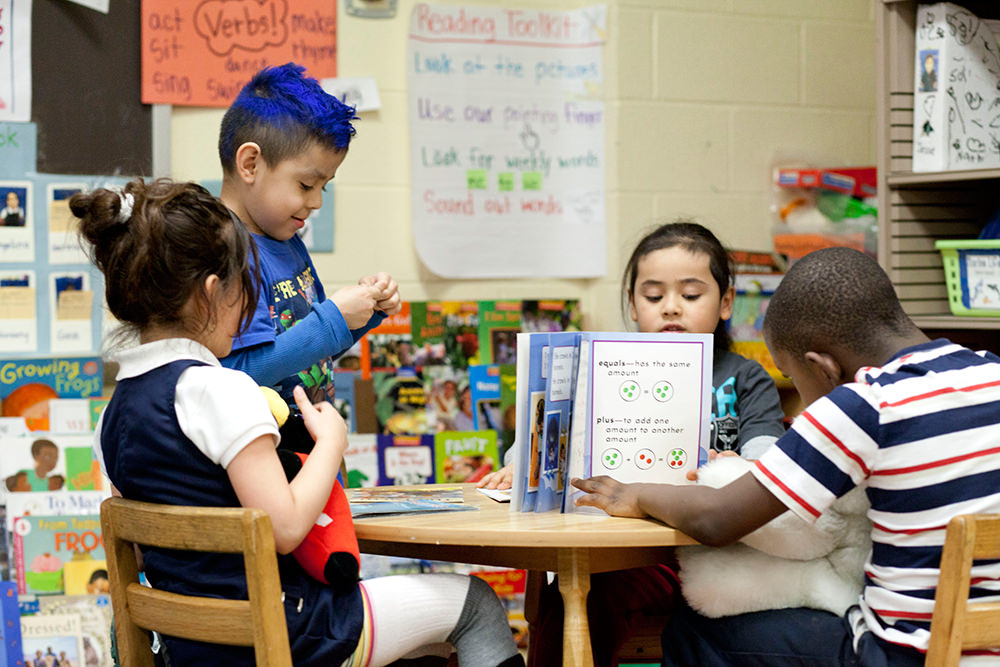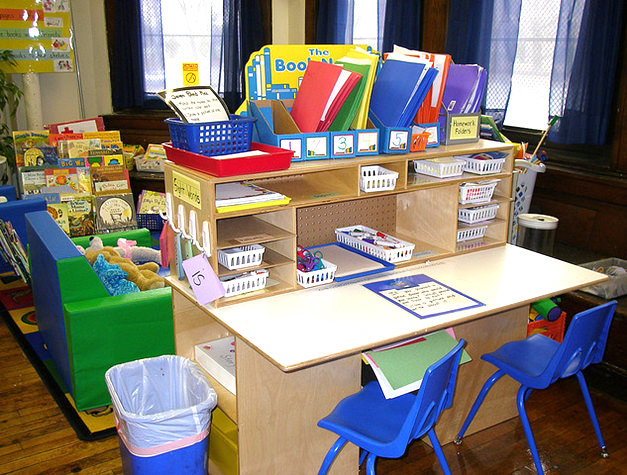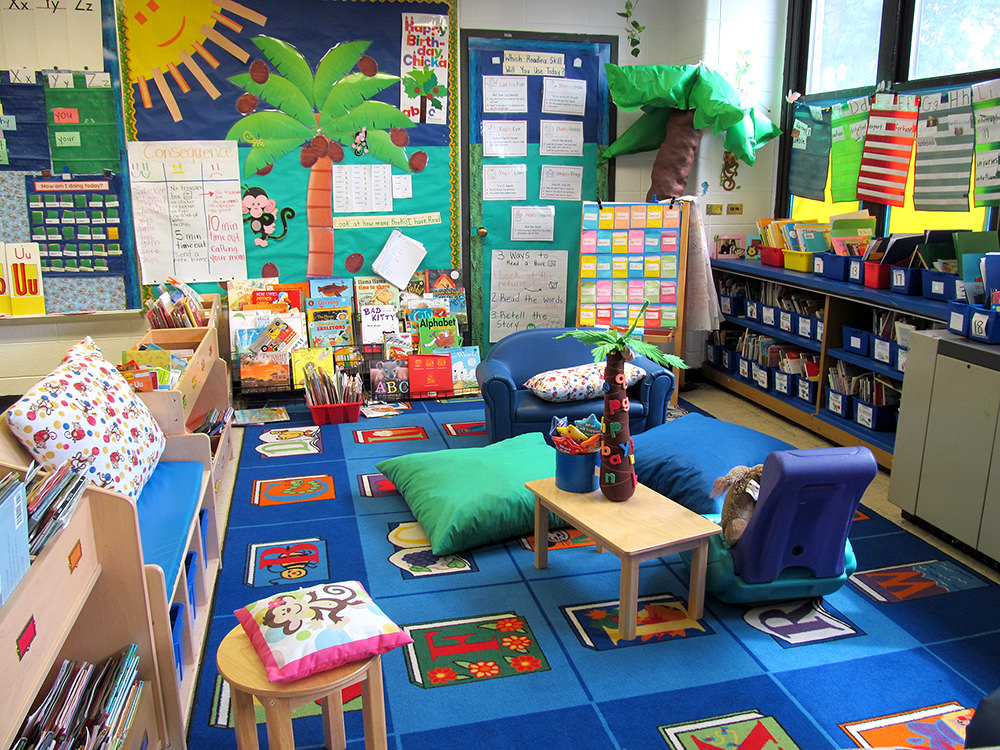Environment: Space
Creating and maintaining an environment that is neat, organized, and inviting helps children learn and feel comfortable, and sends the message that they belong.
It conveys an understanding of the environment as another “teacher” in the classroom that acts as a model for children to apply in their daily life and work. Each space in the classroom is created with children’s learning in mind, and has a clearly defined purpose. Your system and the children’s systems for organizing materials and minimizing clutter are evident. Responsibility for maintaining the organization of the classroom is shared among you and the children. Spaces are appealing places to read, write, think, and talk. When children have access to every space in the classroom that has been designed for their use, they feel ownership and responsibility for these spaces and therefore will contribute to maintaining the space. You are continually planning and reflecting on the use of space in the classroom, and making changes when necessary.
Checklist for Designing Your Classroom Space
There are several aspects of your classroom space that deserve attention and careful thought. Use the following checklist to create child-friendly, warm, and purposeful spaces.
The Large Group Meeting Area
Design is as the heart of the classroom, a place where all children can be seen and heard and can actively participate. It should be a space that can be used for multiple purposes throughout the day, such as whole class instruction, read alouds, and class meetings. Having children sit in close proximity to you and each other promotes natural conversations, allows you to more easily assess children’s understanding, and fosters a sense of community.
__ Select a space with enough room for everyone to fit in rows and/or in a circle.
__ Use carpets and shelves to clearly define the space.
__ Place the space near a board or easel so children’s learning can be charted.
__ Locate the large group meeting area near important displays, such as your word wall, so you and your children can access and refer to them with ease.

Small Group Areas
Provide clearly defined, organized spaces for children to work with their peers or independently. Children should have the opportunity to read and write in every part of the classroom.
__ Create some spaces that are designated quiet and private and other spaces that encourage cooperation and collaboration. Create cozy spaces for reading, writing, and thinking. Include pillows, bean bags, etc.
 __ Use furniture as partitions to help create smaller, purposeful areas. Bookshelves, tables, storage shelves, and chart stands can be used to serve this purpose. When the boundaries of each area are clearly designated, children learn how to use the space effectively. Make sure children are visible from all areas of the room.
__ Use furniture as partitions to help create smaller, purposeful areas. Bookshelves, tables, storage shelves, and chart stands can be used to serve this purpose. When the boundaries of each area are clearly designated, children learn how to use the space effectively. Make sure children are visible from all areas of the room.
__ Include books and other reading and writing materials in each of your small group areas to promote literacy.
__ Shelves, baskets, bins, pocket charts, etc. can be used to organize your materials and ensure that everything the children need is within reach.
__ The display spaces in each of the small group areas should have relevant charts hanging at eye level for the children to access.
The Classroom Library
 The classroom library should be a special place in your classroom in order to highlight the importance of reading, books, and literacy. The library corner is where quality children’s literature is organized, categorized, and displayed and where the leveled library is housed. The classroom library can be filled with inviting items such as lamps and plants and can include cozy spaces where children can read alone or together. In a small classroom, the library corner is often combined with the large group area.
The classroom library should be a special place in your classroom in order to highlight the importance of reading, books, and literacy. The library corner is where quality children’s literature is organized, categorized, and displayed and where the leveled library is housed. The classroom library can be filled with inviting items such as lamps and plants and can include cozy spaces where children can read alone or together. In a small classroom, the library corner is often combined with the large group area.
__ Choose a quiet space away from the busier traffic flow areas.
__ Make the library cozy and inviting. For example, use bean bags, couches, chairs, low tables, pillows, lamps, plants, framed pictures of children reading or favorite book covers, and stuffed animals to create a comfortable environment.
__ Sort your books by theme, genre, author, and level. Include books that reflect children’s home languages.
__ Label shelves and/or book baskets by genre (such as fiction, poetry, etc.). Use picture icons when possible. Display many of your books so the covers are facing out. This will capture your children’s attention.
Your Teacher Space
Minimize your personal space. Design it so it will be a model for children to follow as they learn to care for their own spaces.
__ Place it near cabinets or shelves to help make access to storage easier.
__ Design an organized area or display board for notes, reminders, etc.
__ Declutter. Be sure your teacher space isn’t a repository for stacks of paper.
Children’s Desks
When you arrange children’s desks in table groups, it sends the message that communication and collaboration are essential ingredients in the learning process.
__ Arrange desks and/or tables to promote collaboration.
__ Plan personal space for each child to store their work and personal items. Examples are closet hooks, book bags, cubby holes, work pockets, desk drawers, personal bins, magazine holder, etc.
Create an Organized, Appealing Learning Environment
Create a classroom space that is child-centered and appealing, a place where you and your children enjoy spending time. Being flexible and willing to adapt the classroom to best fit the children and their needs sends the message that the environment is intended to support them in their unique paths to literacy learning. All materials and space should have a purpose. Decide what’s essential to keep for furniture, materials, and storage and free your room from clutter.
__ Clearly label materials for child use and store them at or below eye level.
__ Add cozy touches such as lamps, plants, pillows, and photographs of you and the children.
__ Plan your wall space. Charts that children need to access should be hung at eye level.
__ Displays and charts should only reflect current curriculum and instruction.
Checklist for Working Through Clutter
“I have worked hard, with the help of my coaches, to ‘de-clutter’ my classroom. I removed my BIG teacher desk and now have a smaller table in the very far corner of my classroom so that the focus of my room is my library – not my desk! I threw away a LOT of clutter and especially old text books that I never used anyway! I also got rid of my desk and now have a small plastic table that I used to have in my yard at home. I just painted it red to brighten up my room. I honestly threw out most of my clutter at the end of the year. Once I cleaned out my closets it really helped because then I had more storage for things I wasn’t using.
“I also turned the back part into my ‘office’ so I now have a place for all of my stuff that used to be in piles on my desk! I feel a lot more organized now!!! Now that I am more organized so are my students and it helps me to plan better.” -Michelle Geist, 2nd Grade Model Classroom Teacher, Barton School, Philadelphia, PA
Directions: Read through this checklist. Select the things you want to get started with immediately. Plan what you will work on next.
Tip: You might want to find a partner to help you look at your space with “new” eyes.
| Empty out and sort through one space at a time. Keep in mind: small, simple changes can have dramatic effects. | |
| Make a plan on your calendar for which spaces you will sort through on each day. | |
| Sort items into three piles: Things to Keep, Things to Give Away (to other teachers or kids, to donate, etc.), and Things to Throw Away. | |
Ask yourself these questions when you come to an item you are not sure whether to keep:
|
|
| Only keep furniture and materials that have a clear purpose and are actively used each day. | |
| Remove, clean and/or repair all furniture that is not in good condition. | |
Use the “Two Year Rule” and “Two Inch Rule” to reduce paper clutter.
|
|
| Create a system for filing the children’s work. Consider keeping a “Finished Work Box” where children can file their completed work and a “Checked Work Box” where children can retrieve work you have reviewed. You might also want separate bins for homework papers, one labeled “Homework In” and the other labeled “Homework Out.” | |
Prepare items you will need ahead of time:
|
|
| Once items have been sorted and you set up your literacy stations, store all station supplies in one area so you will know exactly what you have and where it is. Clearly label everything so you and your children know where to return each item. |
Helpful Storage Tips
- Use clear plastic shoeboxes for storage containers so you can easily see what is inside.
- Place materials for each station in separate containers.
- Label materials with re-usable mailing labels.
Desk Arrangement
The way you decide to arrange your children’s desks is important because it conveys messages about how you want your children to learn and interact with each other.
Arrangement of Desks & The Message It Sends to Children
Traditional - Desks in rows facing the teacher at the front of the room.
- “We need to do what the teacher says. The teacher will tell us what to do. There is one way to do things—the teacher’s way. Work is done in our seats and by ourselves.”
Horseshoe - Desks forming a semi-circle around the room.
- “We can have discussions and the teacher is interested in what we have to say. We are expected to think and participate. The teacher will lead discussions and we will work together.”
Table Groups - Desks arranged in groups, with additional large and small group meetings areas in the classroom.
- “We will be learning together in different ways and in different spaces around the room. We are all learners and will work together. My teacher cares about what I think.”

Comments (26)
Log in to post a comment.